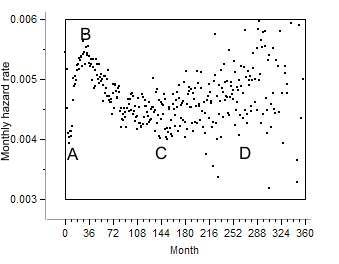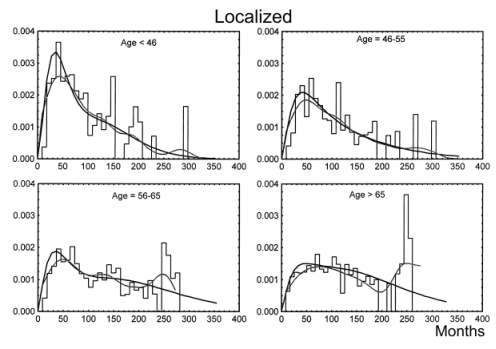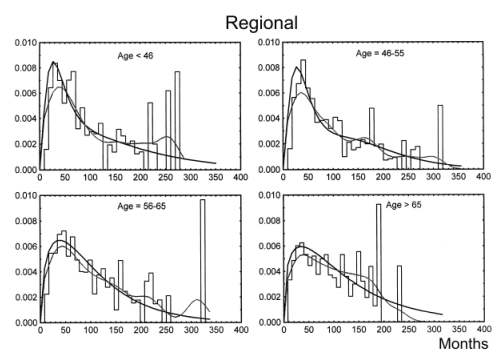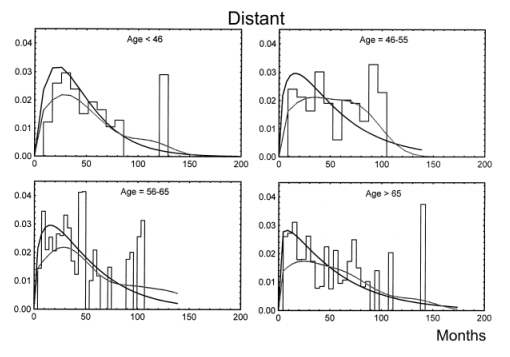 |
Yakovlev et al (1) examined breast cancer survival of 13,166 women which were identified through the Utah Cancer Registry and stratified by clinical stage and age at diagnosis. The following figures are reproduced from their paper:
 |
Hazard rates for different age categories of patients with localized breast carcinoma. The stepwise curve represents the life table estimate, the dotted line represents the kernel estimate, and the solid line represents the maximum likelihood parametric estimate. The life table estimates were based on 40 equidistant time points, with the largest one at the time of the last failure. (Yakovlev et al Figure 4)
 |
Hazard rates for different age categories of patients with regional breast carcinoma. (Yakovlev et al Figure 5)
 |
Hazard rates for different age categories of patients with distant breast carcinoma. (Yakovlev et al Figure 6)
The peak hazard values were read from the figures. They display two trends:
1. Peak hazard declines with age.
2. Peak hazard rises with tumor stage.
| Age |
Localized |
Regional |
Distant |
| <46 |
0.0033 |
0.0082 |
0.0320 |
| 46-55 |
0.0021 |
0.0080 |
0.0300 |
| 56-66 |
0.0020 |
0.0065 |
0.0300 |
| >65 |
0.0016 |
0.0060 |
0.0280 |
Peak hazard is highest in young females and lowest in old
age. Young females are more dependent on the tumor than old , which was demonstrated
in other studies as well. Old females manage to live with their cancer better
than young.
v Treatment promotes cancer progression
v. Age adjusted cancer rates
v. Cancer in elderly is less aggressive
than in the young females
The declining peak hazard with age is a manifestation of a more profound epidemiologic
cancer feature. From the third year after cancer treatment and on, cancer
hazard declines.
v. Conditional cancer survival
In summary, two processes contribute to the peak hazard,
age and stage. Yet there is another factor involved, tumor dependency.
In localized cancer the peak hazard is lower than in distant disease, yet
it declines faster. The following table depicts peak hazard
fractions: hazard[age] / hazard[age>65]
| Age |
Localized |
Regional |
Distant |
| <46 |
2.06 |
1.37 |
1.14 |
| 46-55 |
1.31 |
1.33 |
1.07 |
| 56-66 |
1.25 |
1.08 |
1.07 |
| >65 |
1.00 |
1.00 |
1.00 |
The steeper the slope the more dependent is the patient on
her tumor. In localized tumor, treatment generally removes the entire tumor
and the patient condition aggravates. In regional and distant cancers, patient
is protected from surgical ablation by metastasis. Young females display
the highest fraction (2.06) indicating
that their tumor dependency is highest.
References
1. Andrej Y. Yakovlev, Alexander D. Tsodikov, Kenneth Boucher , and Richard
Kerber,
The shape of the hazard function in breast carcinoma.
Curability of the disease revisited
Cancer Volume 85,
Issue 8, Pages 1789-1798